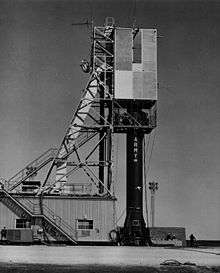Sparta (rocket)
The Sparta was a three-stage rocket that launched Australia's first Earth satellite, WRESAT, on 29 November 1967.
 | |
| Function | Sounding rocket Launch system |
|---|---|
| Manufacturer | ABMA/Chrysler |
| Country of origin | United States |
| Size | |
| Height | 21.8 metres (72 ft) |
| Diameter | 1.78 metres (5 ft 10 in) |
| Mass | 30,000 kilograms (66,000 lb) |
| Stages | 3 |
| Capacity | |
| Payload to LEO | 45 kilograms (99 lb) |
| Associated rockets | |
| Family | Redstone |
| Comparable | Jupiter-C Juno I |
| Launch history | |
| Status | Retired |
| Launch sites | Woomera Test Range LA-8 |
| Total launches | 10 |
| Successes | 9 |
| Failures | 1 |
| First flight | 28 November 1966 |
| Last flight | 29 November 1967 |
| Notable payloads | WRESAT |
| First stage – Redstone | |
| Engines | 1 A-7 |
| Thrust | 416 kilonewtons (94,000 lbf) |
| Specific impulse | 265 sec |
| Burn time | 155 seconds |
| Fuel | LOX/Hydyne |
| Second stage – Antares-2 | |
| Engines | 1 X-259 |
| Thrust | 93 kilonewtons (21,000 lbf) |
| Specific impulse | 293 sec |
| Burn time | 36 seconds |
| Fuel | Solid |
| Third stage – BE-3 | |
| Engines | 1 solid |
| Thrust | 34 |
| Burn time | 9 seconds |
| Fuel | Solid |
Sparta used a surplus American Redstone as its first stage, an Antares-2 as a second stage, and a BE-3 as a third stage. Several Spartas were launched from 1966–67 from Woomera Test Range in Woomera, South Australia as part of a joint United States–United Kingdom–Australian research program aimed at understanding re-entry phenomena, and the U.S. donated a spare for the scientific satellite launch into polar orbit.
The first stage was recovered from the Simpson Desert in 1990 after being found in searches by explorer Dick Smith the previous year.[1]:76–80

Sparta on the pad at Woomera
References
- Douherty, Kevin. "Retrieving Woomera's Heritage" (PDF). Retrieved 3 August 2016. Cite journal requires
|journal=(help)
- Wade, Mark. "Redstone". Encyclopedia Astronautica. Archived from the original on 2009-04-15. Retrieved 2009-04-07.
This article is issued from Wikipedia. The text is licensed under Creative Commons - Attribution - Sharealike. Additional terms may apply for the media files.